

National Geographic Education. Chapter 4 - Ecosystems and Biomes. Nature Explorations. Investigating Local Ecosystems. Purpose To investigate the habitats of local plants and animals and explore some of the ways animals depend on plants and each other.
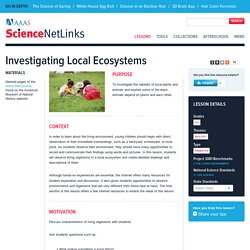
Context In order to learn about the living environment, young children should begin with direct observation of their immediate surroundings, such as a backyard, schoolyard, or local pond. As students observe their environment, they should have many opportunities to record and communicate their findings using words and pictures. In this lesson, students will observe living organisms in a local ecosystem and create detailed drawings and descriptions of them. Although hands-on experiences are essential, the Internet offers many resources for student exploration and discussion. Motivation Discuss characteristics of living organisms with students. Ask students questions such as: What makes something a living thing? You could present students with a living plant or animal as an example and ask questions such as: Is this alive?
Development Then ask students: Assessment. Online Field Journals. Ecosystem. Ecosystem What exactly is an ecosystem?
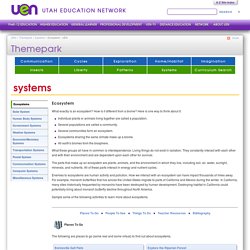
How is it different from a biome? Here is one way to think about it: Individual plants or animals living together are called a population. Several populations are called a community. What these groups all have in common is interdependence. The parts that make up an ecosystem are plants, animals, and the environment in which they live, including soil, air, water, sunlight, minerals, and nutrients. Enemies to ecosystems are human activity and pollution.
Sample some of the following activities to learn more about ecosystems. Places To Go People To See Things To Do Teacher Resources Bibliography Places To Go The following are places to go (some real and some virtual) to find out about ecosystems. Bonneville Salt Flats This flat, white, barren destination is very unique and shouldn't be overlooked. Great Salt Lake Visit the Great Salt Lake. Virtual Yosemite Take a virtual tour of Yosemite by way of the webcams on this site. People To See Robert E. Things To Do. Utah Live Webcams - AllTravelCams.com. The Great Basin Ecology Laboratory USDA-FS-RMRS. Welcome The Nevada Forestry Sciences Laboratory is part of the USDA Forest Service, Rocky Mountain Research Station and is located on the University of Nevada, Reno campus.
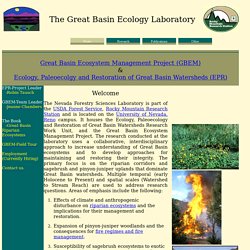
It houses the Ecology, Paleoecology and Restoration of Great Basin Watersheds Research Work Unit, and the Great Basin Ecosystem Management Project. The research conducted at the laboratory uses a collaborative, interdisciplinary approach to increase understanding of Great Basin ecosystems and to develop approaches for maintaining and restoring their integrity. The primary focus is on the riparian corridors and sagebrush and pinyon-juniper uplands that dominate Great Basin watersheds.
Multiple temporal (early Holocene to Present) and spatial scales (Watershed to Stream Reach) are used to address research questions. Effects of climate and anthropogenic disturbance on riparian ecosystems and the implications for their management and restoration. Utah Conservation Data Center. An integral part of the Utah Division of Wildlife Resources, the Utah Conservation Data Center (UCDC) is the central repository for Utah biodiversity information.
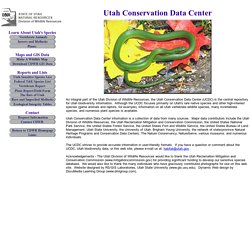
Although the UCDC focuses primarily on Utah's rare native species and other high-interest species (game animals and raptors, for example), information on all Utah vertebrate wildlife species, many invertebrate species, and numerous plant species is available. Utah Conservation Data Center information is a collection of data from many sources. The UCDC strives to provide accurate information in user-friendly formats.
If you have a question or comment about the UCDC, Utah biodiversity data, or this web site, please e-mail us at: habitat@utah.gov. Acknowledgements - The Utah Division of Wildlife Resources would like to thank the Utah Reclamation Mitigation and Conservation Commission (www.mitigationcommission.gov) for providing significant funding to develop our sensitive species database. Utah Habitats, Plants and Animals. Wetland Ecosystem Education Home Page. Today less than 1% of Utah's total land is wetlands.
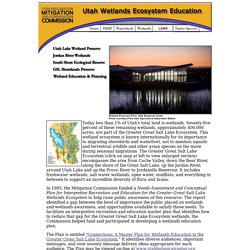
Seventy-five percent of these remaining wetlands, approximately 400,000 acres, are part of the Greater Great Salt Lake Ecosystem. This wetland ecosystem is known internationally for its importance to migrating shorebirds and waterfowl, not to mention aquatic and terrestrial wildlife and other avian species on the move during seasonal migrations. The Greater Great Salt Lake Ecosystem (click on map at left to view enlarged version) encompasses the area from Cache Valley, down the Bear River, along the shore of the Great Salt Lake, up the Jordan River, around Utah Lake and up the Provo River to Jordanelle Reservoir. It includes freshwater wetlands, salt water wetlands, open water, mudflats, and everything in between to support an incredible diversity of flora and fauna. The Plan is entitled "Connections: A Master Plan for Wetlands Education in the Greater Great Salt Lake Ecosystem. " Wonderopolis.